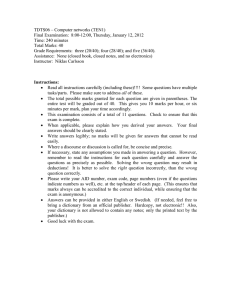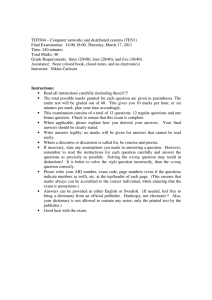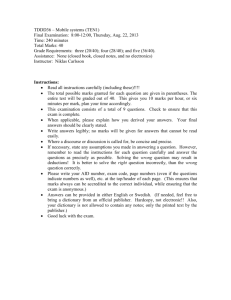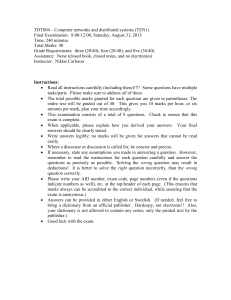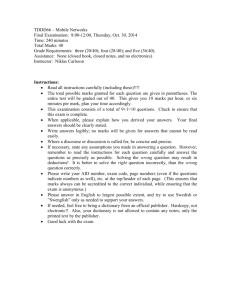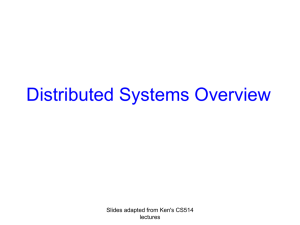TDTS04 – Computer networks and distributed systems (TEN1)
advertisement
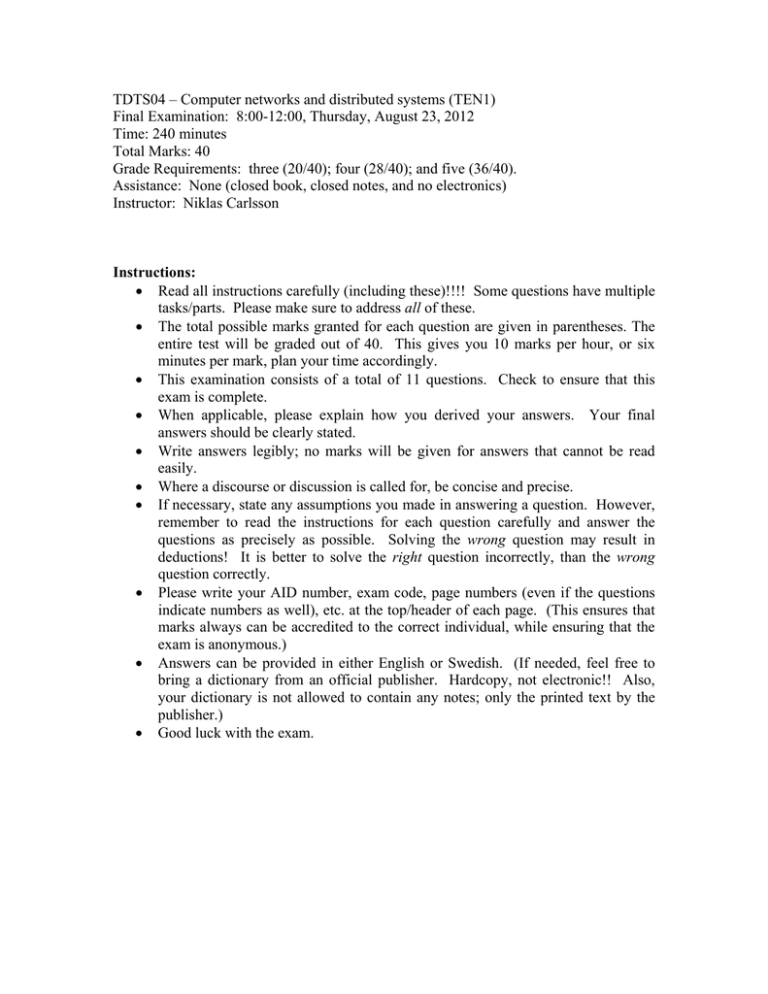
TDTS04 – Computer networks and distributed systems (TEN1) Final Examination: 8:00-12:00, Thursday, August 23, 2012 Time: 240 minutes Total Marks: 40 Grade Requirements: three (20/40); four (28/40); and five (36/40). Assistance: None (closed book, closed notes, and no electronics) Instructor: Niklas Carlsson Instructions: • Read all instructions carefully (including these)!!!! Some questions have multiple tasks/parts. Please make sure to address all of these. • The total possible marks granted for each question are given in parentheses. The entire test will be graded out of 40. This gives you 10 marks per hour, or six minutes per mark, plan your time accordingly. • This examination consists of a total of 11 questions. Check to ensure that this exam is complete. • When applicable, please explain how you derived your answers. Your final answers should be clearly stated. • Write answers legibly; no marks will be given for answers that cannot be read easily. • Where a discourse or discussion is called for, be concise and precise. • If necessary, state any assumptions you made in answering a question. However, remember to read the instructions for each question carefully and answer the questions as precisely as possible. Solving the wrong question may result in deductions! It is better to solve the right question incorrectly, than the wrong question correctly. • Please write your AID number, exam code, page numbers (even if the questions indicate numbers as well), etc. at the top/header of each page. (This ensures that marks always can be accredited to the correct individual, while ensuring that the exam is anonymous.) • Answers can be provided in either English or Swedish. (If needed, feel free to bring a dictionary from an official publisher. Hardcopy, not electronic!! Also, your dictionary is not allowed to contain any notes; only the printed text by the publisher.) • Good luck with the exam. TDTS04 – Computer networks and distributed systems Final Exam: 8:00-12:00, Thursday, August 23, 2012 1) Question: Forwarding (4) Show, illustrate, and explain the path of a Hyper Text Transfer Protocol (HTTP) POST message (that fits into a single frame) as it is sent from a client to a Web server. You can make the following assumptions: • The client machine uses Ethernet, has a single interface with a MAC address AA:AA:AA:AA:AA:AA and an IP address 111.222.111.222 • The MAC and IP addresses of the HTTP server are DD:DD:DD:DD:DD:DD and 222.222.111.111. Similar to the client, the server has a single interface. • The gateway router closest to the client has four interfaces. The first is the interface closest to the client and has MAC and IP addresses BB:BB:BB:BB:BB:BB:BB and 111.222.111.111. The second interface has MAC and IP addresses CC:CC:CC:CC:CC:BB and 111.222.122.122. The third interface has MAC and IP addresses AA:CC:AA:CC:AA:CC and 111.222.133.133. Finally, the fourth interface has MAC and IP addresses AA:AA:AA:DD:DD:DD and 111.222.144.144. • The routing table at the gateway router has many entries. However, for this question, the three most closely matching entries for each interface states 222.222.0.0/16 (over interface 2), 222.222.192.0/18 (over interface 3), and 222.222.0.0/18 (over interface 4). In addition to the above answers, you should also draw a picture of the topology and clearly state any assumptions you make about the topology (including parts of the networks not explained above) or anything else needed to solve the question. As with all your answers it is important that you also explain how you derived your answer. For example, why was the packet taking this particular route? 2) Question: Encapsulation (5) Consider the same scenario as in question 1. Show and illustrate the single link-layer frame for the Hyper Text Transfer Protocol (HTTP) POST message (that fits into a single frame) when it is passed down to the physical layer of the client on its way towards the Web server. You do not have to show all the details of the different headers; however, you should (i) specify what protocols the different headers are associated with, and (ii) provide the address information associated with the source and destination fields for each of the different headers (contained within this frame). 3) Question: HTTP (4) Performance and personalized service are important aspects of building good Web services. Please draw a picture and explain how a Web page with two embedded images is obtained if the browser and server are communicating with pipelined HTTP (rather than non-persistent HTTP/1.0). Your figure should clearly show connection establishment and teardown messages, as well as any other messages needed for the file transfer. You can assume that the HTML page and each of the images are 2KB, and the MSS is 1.5KB. 2 TDTS04 – Computer networks and distributed systems Final Exam: 8:00-12:00, Thursday, August 23, 2012 4) Question: TCP slow start (5) Consider two machines A and B which are located 120ms apart. Assume that A is requesting a file from B using HTTP. Draw a figure and explain the entire communication sequence, including TCP handshake and connection teardown. You can assume that the payload is 20 packets and each packet can be sent in 0.1ms. You can assume that packet eight (8) is lost. For simplicity, you can assume that the TCP version is implementing fast retransmit, initially have ssthresh = 4, and the timeout period is constant at 300ms. 5) Question: Distance vector routing (4) Consider a node A with neighbors B, C, and D. Node A currently has the distance table below. (Note that the network currently may not be in a very good shape, and a few routing table updates may be needed to get the network back into shape.) Assume that A receives an updated distance vector from neighbor B which looks as follows [∞, 0, 3, 4, 3, 4, 3]. First, update the table below, including A’s own distance vector. Second, assume that poison reverse is implemented, and show (and explain) exactly what information the node sends to each its neighbors (after the table has been updated). Destination A B C D E F G A (via) 0 (A) 1 (B) 1 (C) 1 (D) ? (?) ? (?) ? (?) Costs B C D ∞ ∞ ∞ 0 8 2 8 2 8 7 0 3 9 4 6 6 2 0 2 6 6 6) Question: BGP routing (4) Please explain how the Border Gateway Protocol (BGP) picks between two paths. The first path has a one-way delay of 150ms, three AS-hops, and the other path has a one-way delay of 100 ms, and is three AS-hops away. (Here, AS stands for Autonomous System.) Your answer should explain any assumptions you must make regarding the use of different gateways, their distance to the current router, as well as the impact of any potential business agreements between the different AS. Please use a picture and carefully explain your answer. 7) Question: TCP (2) Please provide an example (using a figure and supporting text) of a triple duplicate ACK, and carefully explain what it is and what actions typically are taken at such an event. 3 TDTS04 – Computer networks and distributed systems Final Exam: 8:00-12:00, Thursday, August 23, 2012 8) Question: Transparency (4) Please give two concrete examples illustrating where and how transparency is implemented in some example distributed system(s), and explain why transparency is important in such a distributed system. 9) Question: Lamport’s clock (4) Assume that you have three processes p1, p2, and p3 which are implementing Lamport’s clocks. There are many events that take place at these processes, including some messages being sent between the processes. In the figure below we use circles and arrows to specify in-processor events and messages being sent between processes, respectively. Please provide the logical timestamps associated with each event. You can assume that all three clocks start at zero, at the left-most point in time. (Also, explain how the processes would adjust their clocks if using Lamport’s logical clocks.) time @ p1 time @ p2 time @ p3 10) Question: Asynchronous calls (2) Please explain the advantage and disadvantages of asynchronous calls compared to synchronous calls. Also, please give a concrete example where such functionality could be beneficial. 11) Question: Skype (2) It appears that Skype uses peer-to-peer for voice calls and client-server for video calls. Please explain and discuss the design tradeoff using peer-to-peer and client-server in the context of Skype (and similar communication services). You may want to illustrate and discuss what processing takes place where, and how these design choices may impact performance. Good luck!! 4
